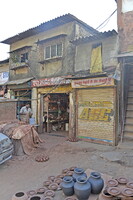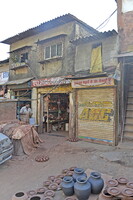| dc.coverage.spatial | Creation Site: Mumbai, Mahārāshtra, India, Asia, | en_US |
| dc.coverage.temporal | photographed 2011 (creation) | en_US |
| dc.creator | Gilchrist, Scott | en_US |
| dc.date | 2011 | en_US |
| dc.date.accessioned | 2014-12-22T16:00:33Z | |
| dc.date.available | 2014-12-22T16:00:33Z | |
| dc.date.issued | 2011 | en_US |
| dc.identifier | 253989 | en_US |
| dc.identifier.other | archrefid: 3146 | en_US |
| dc.identifier.uri | http://hdl.handle.net/1721.3/169628 | |
| dc.description | Typical pottery shop; Sion is the last locality within the City limits of Mumbai, to the south. In the 17th century the village formed the boundary between Mumbai and Salsette Island. The name comes from Portuguese Jesuits (who controlled the area from 1543) who built a chapel on the hill near the present-day railway station and named it after Mount Zion (Sion) in Jerusalem. The Dharavi slum lies just to the north east. Source: Wikipedia; http://en.wikipedia.org/wiki/Main_Page (accessed 7/26/2014) | en_US |
| dc.format.medium | digital photographs | en_US |
| dc.rights | © Scott Gilchrist, Archivision, Inc. | en_US |
| dc.subject | cityscape | en_US |
| dc.subject | contemporary (1960 to present) | en_US |
| dc.subject | Twenty-first century | en_US |
| dc.title | Mumbai: Sion Pottery district; Topographic Street Views | en_US |
| dc.type | image | en_US |
| dc.rights.access | Licensed for educational and research use by the MIT community only | en_US |
| dc.identifier.vendorcode | 1A2-IN-STV-B15 | en_US |
| vra.culturalContext | Indian | en_US |
| vra.technique | photography | en_US |
| vra.worktype | topographical view | en_US |
| vra.worktype | photograph | en_US |
| dc.contributor.display | Scott Gilchrist (Canadian distributor, born 1960) | en_US |

